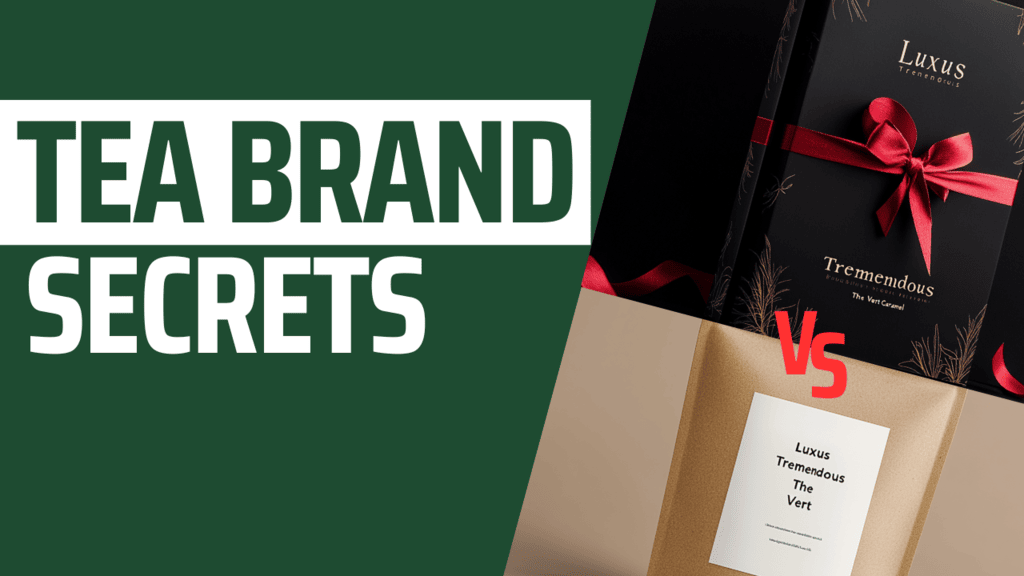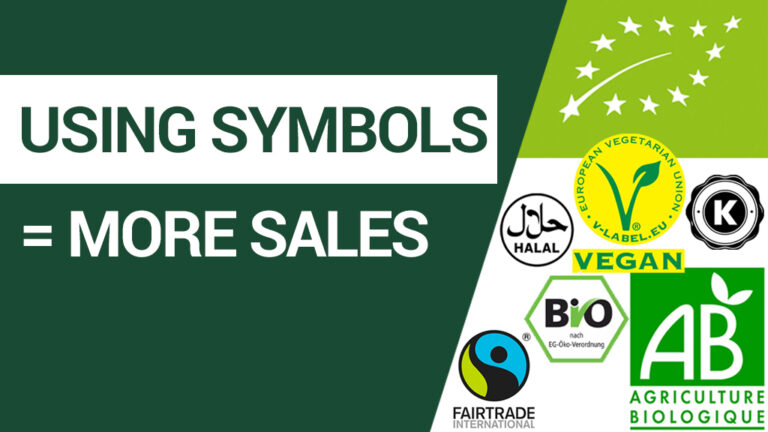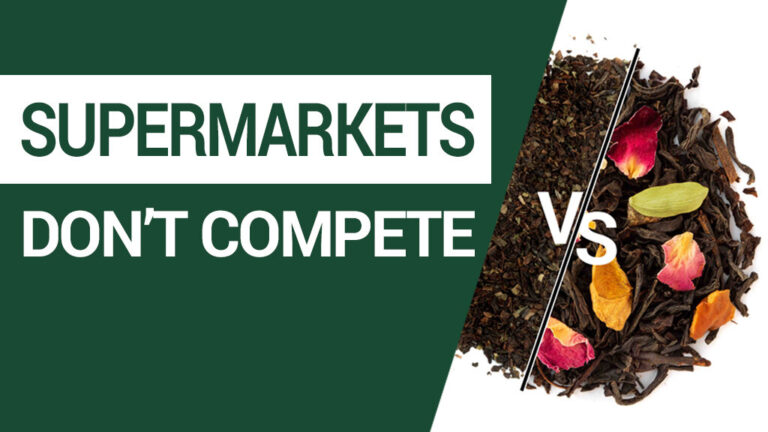If I ask you, what is THE word that defines great tea houses?
Tea? Quality? High-end?
None of the above!
The correct answer is “gift”.
Mark my words dear reader. Most brand creators think about tea when they should be thinking about presents, gifts, or souvenirs.
Why is this important?
If your product is perceived as a gift:
- You sell to more people,
- on more occasions,
- at a higher price,
So don’t think ready-to-sell, think ready-to-offer.
And if you want to give your brand a chance in this business, confront your tea brand project with the 2 questions we’re about to address:
- Why should your tea brand’s products also be perceived as a gift idea?
- What are the 3 attributes that make your product a gift? Here we will talk about price, packaging and storytelling.
And as a bonus, we’ll see how this rule doesn’t (generally) apply to the brands sold in supermarkets.
Table of Contents
ToggleWhy is your tea packaging a gift in disguise?
This is the key:
You’re not selling tea, you’re selling a gift.
Why?
The first time I realized this was in Paris a few years ago. A guy and his wife sat down next to us on the terrace of a restaurant. They’re Americans. He laid a shopping bag from Mariage F on the floor. The bag is stuffed to the gills. From the looks of it, he had at least 200 dollars worth of purchases.
Do you think all those tins and teabags packages were for him?
No. They were just presents he was going to give his family back home.
A few days later, I accompanied a friend to the train station Montparnasse in Paris. His job: headhunter in the IT sector. Why go to Montparnasse? One of his clients is between 2 trains and he has 15 minutes for a coffee with her.
She’s a big customer and my friend does things well. When I met him before his mini-appointment, he had bought for her a box of Pierre Hermé macaroons and … a Mariage F. tea tin.
Is the client a tea lover? I’m not sure. But, once again, the buyer wasn’t the consumer, he was the giver.
The big lesson for me that day:
- Tea is socially accepted as a gift,
- It’s all about appearances. When you give a gift, it has to look like a gift. And a present has certain attributes that must be respected to be perceived as such.
You’ll have a harder time passing off a standard kraft bag with a simple black-and-white label as a gift. Does that make sense? Yes, but that’s the mistake made by 90% of entrepreneurs when they start.
Beyond the gift, what my friend wanted was to get a message across: “You, my customer, I want to show you that you’re important to me”. And when you think about it, he managed to get that message across by buying tea!
Can you imagine the opportunities this opens up regarding new markets and additional occasions to sell your brand?
Occasions like Valentine’s Day, Mother’s Day, Father’s Day, or Christmas, that’s several times a year.
And birthdays, customer appointments… That’s all year long.
You’re no longer selling to the consumer, but to people who want to offer it to others.
These people then spread the word about your brand to their friends, family, or professional contacts. This widens the circle of individuals who know your brand and can consume it, offer it, or simply let others discover it… This is the virtuous circle you want for your brand!
This is the great equation I’ve come to understand while working in the tea business:
Premium brand = premium image = gift idea = more sales opportunities = boosting word-of-mouth.
Tea as a gift is not sold in supermarkets (usually).
You’re bound to say: “When I go into a supermarket, tea packages are not necessarily very classy. And I’d never think of giving a brand sold there as a gift”.
You’re right.
Consumers find it a bit “cheap” to buy food gifts in supermarkets.
But why?
Teas and herbal teas sold in supermarkets have two perception problems:
- Products in this category aren’t expensive enough,
- The products are not special enough.
Buying a gift in a supermarket has connotations: it’s too common, it’s too easy. It gives the impression that the gift-giver didn’t put much care and effort into it.
So tea brands sold in supermarkets are not a gift idea. But that’s normal. That’s not what they’re for. These tea brands are aimed at buyers who are also consumers.
That’s why young tea brand creators shouldn’t waste their time comparing themselves with these brands. They’re not the competition.
What are the characteristics of a premium or luxury brand?
It doesn’t matter what you call them – premium brand, prestige brand, high-end brand, or even luxury brand:
Their product is also a gift.
So the real question for you is this: When do customers perceive tea as a gift?
Here are three characteristics of brands selling ready-to-give tea:
- They avoid standard packaging,
- The price is disconnected from the value of the content,
- They go beyond product features to tell a story.
The price is an indicator of value… and how giftable the product is.
Imagine yourself in the following situation: it’s Mother’s Day.
You’re invited to Mom’s house. You need to find her a last-minute gift.
How about giving her a pack of tea for 2.45 dollars?
Would that be weird? Are you uncomfortable? Then, you’re like most people. That’s why many customers go to specialized tea stores and buy something more suitable.
In Europe, for example, a 100-gram tin costing between 15 and 25 dollars is more appropriate. For gift sets, the price can easily run between 30 and 50 dollars.
This is what should be important to a brand creator when thinking about the price of his products. For most of us, spending 19 euros on 100 grams of tea is unreasonable. But 19 euros for a healthy gift? Why not.
Remember: our perception is a question of context.
Stay away from standard packaging.
I shared my first mantra at the beginning of this post:
Successful shops and premium brands sell tea and herbal tea products… disguised as gifts.
Well, here is my second one:
Most tea shops don’t have a brand. They only have a shop name.
What I mean is that when you look at their product’s packaging, they usually use brown paper doypacks, and stick a generic label in the front containing the shop name, their address, the product name, and the ingredient’s list.
The effort in design is minimal and more importantly, it does not stand out. That’s the reality of many tea stores.
And there are good reasons for that:
- They don’t have a graphic designer at their disposal.
- They don’t have the volume to buy specific labels printed by professionals.
The downside is that their packaging is too generic to be considered giftable by consumers.
Artisanal, local, yes. Giftable, no.
To be giftable, you must level up your product packaging and not settle for standard packaging.
Great packaging increases perceived value. This means that beautiful packaging and presentation give the impression that the product is more luxurious, which justifies higher prices.
This is part of the reason why tea shops are struggling. They’re missing out on buyers who are gift-shopping.
Sure, some will buy their products. But on the whole, they’re losing opportunities.
Is a product’s image limited to its packaging?
The answer is no.
Of course, the rest of your communication needs to be aligned with your brand’s image. Where your products are displayed is just as important.
I’m stressing packaging here because it’s your main selling argument in the store. The buyer stands in front of your tin of herbal tea, his credit card in his pocket. He either buys or he doesn’t.
In that sense, it’s your main weapon for convincing buyers that your product is a good gift idea…
An additional thought for skeptical readers.
You might have a doubt. After all, you’ve seen premium brands where tea was packaged in a simple black plastic bag. A common closing clip was used to “seal” the bag, a simple sticker with the brand name and some product information was applied to the packaging.
It’s not luxury, it’s true.
But there are two things to bear in mind:
- It’s generally the cheapest packaging solution you’ll find in their stores. In fact, this type of packaging is more of a “refill” for products that can also be purchased in nicer, more premium packaging solutions (such as tins).
- It’s the brand name that sells, not just the packaging.
If you are an unknown brand, you don’t exist in the consumer’s mind. So the person who receives your tea as a present will probably have no clue who you are.
Well-known high-end brands already exist in the consumer’s mind. Chances are, the brand will be perceived as prestigious and expensive by both giver and receiver.
The perception of the brand is enough to trigger gift-related purchases.
In other words, the brand itself is a gift.
Sure, some packaging styles they propose are not optimal. But the value of the brand makes up for its minor shortcomings.
What does it mean for you?
If you are not perceived as a premium or luxury brand, you will have more difficulty convincing people to buy your products as presents. Yes, it will happen from time to time. But overall many potential buyers will pass on you and go for a safer choice.
The easiest thing you can do is level up your packaging to become giftable.
You might say “Why not work on my branding? I can improve how my brand is perceived”. I agree 100%. But it’s a much longer road to travel. And we’ll be tackling this subject in new articles…
High-end brands tell a story.
I know. The word “storytelling” has been thrown around a lot in recent years. To the point where we don’t even understand what it stands for anymore.
So I’ll get back to basics.
What are we talking about when we mention storytelling? Well, first I’ll show you the opposite.
Not adding storytelling to your product’s sales pitch looks like this: “This blend contains 60% Sencha green tea and is rich in antioxidants. Certified organic by Ecocert. Its 3-layer bag protects the flavorings. Contains 100 grams.”
See what I’m doing here? I focus on facts and product features. That’s it. No emotion. No story.
Do you think it’s appealing?
Would you buy it?
Give it away?
Now I’ll show you the other way around.
Do you know Rainbow Wool?
Listen carefully to what follows:
Rainbow Wool is the first fashion collection made from the wool of gay sheep.
Maybe you didn’t know it, but about 1 in 12 sheep are gay. And when they’re spotted in a flock, our tender rams are sent straight to the slaughterhouse since they’re unable to fulfill their “reproductive role”.
But what does Rainbow Wool do?
They buy the rams before they are sent to slaughter. And they use their bushy fur to make the first pro-LGBTQIA+ wool.
You heard me right. In the end, what they’re selling is wool!
They’re selling a product whose trade is even older than tea. But, the narrative that leads to this product is completely new.
They’re not selling you their product anymore. They’re selling you their story. Their cause, their storytelling.
Then you either buy in or you don’t. That’s not the point.
What’s important is that they’re completely different. They have a unique story to tell, and one with which some of their customers will identify.
Back to your brand. You are facing hundreds of competitors. Selling tea for tea’s sake – without storytelling – is dead. Leave that to the supermarket brands.
So let me ask you this:
What’s going to make your brand interesting?
What sets it apart?
Why will some customers identify with it and buy it?
In short, what’s your story?
To remember.
For your tea brand to be perceived as a gift idea, you must improve the packaging and have a story to tell.
Don’t forget:
High-end and luxury brands sell tea disguised as a gift.
As a result, they appeal to a wider range of customer types who have more occasions to buy tea and herbal tea. This is one of the reasons for their success.
To sum up, there’s no reason not to “put a bow” on your packaging.
So what’s next? Ask yourself:
- Have you ever questioned the giftability of your packaging?
- Do you know what shoppers think about the look and feel of your products?
- What are you doing to improve their perception?




